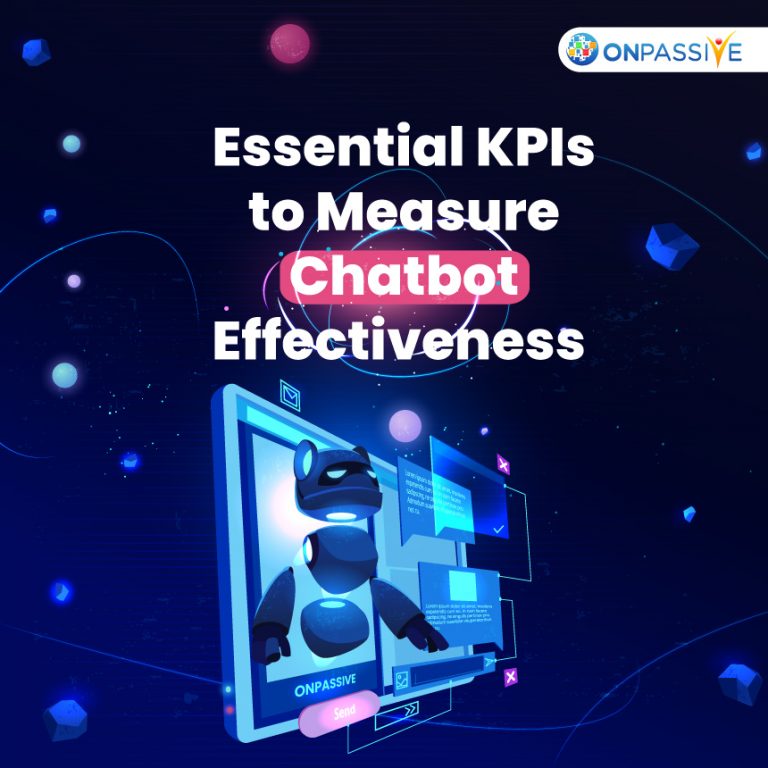
Most businesses are now integrating AI-powered chatbots with their websites to enhance their customer service and extend their availability of online support to potential customers.
AI-chatbots are programmed in such a way that they can stimulate user conversation through messaging applications in natural language similar to a human conversation. As a result, it enables companies to increase their user response rate while being available round the clock on their website. Thus, AI-chatbots save time and money for companies while enabling them to improve their customer services.
Organizations that are leveraging AI-chatbots can transform their businesses. But before that, they need to determine chatbot KPIs, essential metrics to ensure a feedback loop attached with the chatbot to understand and evaluate its success rate and customer satisfaction rates.
Many leading companies, including ONPASSIVE, are now utilizing the power of AI chatbots to replace their sales and service agents. ONPASSIVE chatbot or “O-Chat” is an intelligent virtual assistant which helps to boost sales growth and uses natural language understanding to respond to customer queries in real-time quickly.
ONPASSIVE chatbot is designed with self-learning algorithms that help identify the intent of customer conversation and respond accordingly.
Therefore ONPASSIVE chatbot or O-Chat enables the company to take its customer support to the next level with inbuilt AI programming and increases customer satisfaction.
Essential KPIs to Measure Chatbot Effectiveness
The following are the essential chatbot KPIs or key performance metrics that help companies measure and evaluate the effectiveness of chatbot for business:
Chatbot Activity Volume
Chatbot activity volume is measured to evaluate the number of interactions and tracks the conversation from a simple start until its progress to a constructive dialogue. It provides organizations with insights into how frequently the chatbot is used and if its number is increasing.
Total number of users
This chatbot KPI represents the total number of users that have used or engaged with your chatbot. However, if the number of users is low, companies need to make the necessary changes to make the AI chatbot more effective.
Bounce Rate
The bounce rate is a chatbot KPI that corresponds to the volume of user sessions that failed to interact or use your chatbot and provides insights on how many people visited your website without seeing or using the AI chatbot.
Completion Rate
The completion rate of your chatbot is a chatbot KPI which shows the success rate of the defined action of your AI-chatbot. The higher the completion rate, the better for your business as it indicated the success of your objective.
Chatbot Response Time
Chatbot response time is a chatbot KPI which shows how quickly your chatbot responds to your customers or website visitors.
Fallback Rate
Suppose the fallback rate of your chatbot is increasing. It’s time to restructure it because this chatbot KPI refers to the failed response of the chatbot or the number of times your chatbot failed to understand user queries or failed to redirect them appropriately.
Most Frequently Asked Questions
This is a crucial chatbot KPI or metric which shows the most frequently asked questions by your customers that helps you gather data on customers views and concerns.
Activation Rate
Activation rate is a key chatbot KPI that shows how many users engage in more tasks after finishing the initial conversations. This helps how well you have contributed to its activation rate.
Human Vs Chatbot Interaction
The human vs chatbot interaction rate is a key performance metric that shows how efficiently the chatbot is routing the conversation to the human agent as it can’t answer all the questions.
Customer Satisfaction Rate
The customer satisfaction rate is the most crucial chatbot KPI, which shows how happy your customers are with your chatbot abilities. The higher the rate, the more satisfied your customers are and the more successful your business is.
These chatbot KPIs are essential for companies and enable them to track, measure and evaluate the effectiveness of AI-chatbots. By understanding the effectiveness of chatbots for business, organizations can enhance their customer support.
Conclusion
The chatbot success metrics need to correlate with the audience segment. Therefore, companies need to define goals, objectives, and business metrics to receive insights on customers’ needs and business requirements provided by the AI-chatbots.
However, organizations need to ensure that they train and monitor chatbots to continue gaining the competitive advantage of using AI-chatbot to extend customer support of their business.


